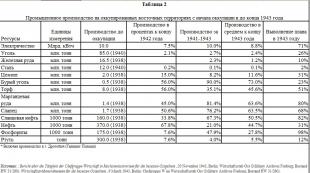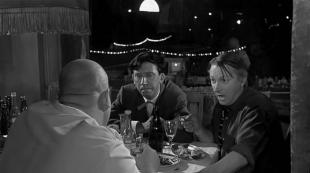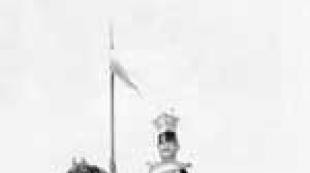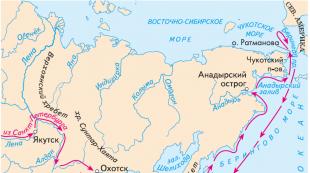Generalized results on the questionnaire "identification of essential features" of students. Technique "highlighting essential features" Garden plants gardener fence earth dog informatics
“He is so inattentive,” parents complain about their unfortunate student, “he writes a dictation and there is a mistake in every line! But he knows the rules by heart!” And indeed, wake up such a "literate" in the middle of the night - he will read them by heart, like a prayer.
But such a student cannot see a specific comma behind an abstract rule. And the reasons for the troubles with studies are not a lack of attention, but problems with thinking, verbal and logical generalization.
How developed is your child's ability to generalize? Let's check this with a test.
Prepare 8 cards, each of which depicts four objects (their examples are in the figure). Explain to the child that one of the drawn objects is superfluous. Show the cards and ask on each of them to find this item and say why it is superfluous. Children 5-6 years old must first be shown a training card and the first task to be dismantled with them. They must complete the tasks of the remaining 7 cards without errors in no more than 2 minutes.
Schoolchildren should be able not only to clearly explain the reason for the exclusion of the subject, but also to find a general concept for a group of three subjects.
Children 7-9 years old must complete the task without a training card in 1 minute, 10-11 year olds- in 40 seconds.
If, when completing a task, a child not only exceeds the time limits, but also makes 3-4 mistakes, this is a cause for concern and targeted exercises to correct visual-figurative and verbal-logical thinking.
To train the ability to distinguish essential features from non-essential ones, such a task is useful. To complete it, you need a sheet of paper with rows of words printed on it:
GARDEN (plants, gardener, dog, fence, earth)
RIVER (shore, fish, angler, mud, water)
CITY (car, buildings, crowd, faces, bike)
BARN (hayloft, horse, roof, livestock, walls)
READING (eyes, book, text, glasses, word)
DIVISION (class, dividend, pencil, divider, paper)
CUBE (angles, drawing, side, stone, wood).
In each line, one word comes before the brackets, and five others come after them. All the words in brackets have something to do with the one before the brackets. Invite the child to choose only the 2 that are most related to the word before the brackets. For example, a garden can exist without a dog, a fence, and even a gardener, but it cannot exist without land and plants.
Words in tasks must be chosen so that it becomes possible not only to catch the abstract meaning of certain concepts. The child must refuse the “temptation” to choose a conspicuous, but incorrect way of solving, in which private, specific situational signs are singled out instead of essential ones. Guided by this rule, select 15-20 rows of words for one task.
As an exercise, you can use the verbal version of our test.

Prepare a letterhead with typed (or handwritten) series of five words (at least 10 series). In each line, you need to find an extra word, and combine 4 others into one group and give it a name.
For example:
- deep, high, light, low, shallow;
- Vasily, Peter, Semyon, Ivanov, Fedor;
- house, dream, car, cow, tree;
- hammer, pliers, saw, nail, ax;
- brave, brave, resolute, evil, courageous;
- football, volleyball, hockey, swimming, basketball;
- turner, teacher, book, doctor, astronaut; and etc.
Analyze the task with the child and make sure it is done correctly. Some children make an erroneous generalization on an unimportant basis. If, however, the attention of such a child is drawn to the clarification of causal relationships, he can change his answer to the correct one and will not make such mistakes in the future. This happens in children with unstable thinking.
When a child, with a correct decision, finds it difficult to motivate his answer and formulate a generalizing concept, this indicates the unconsciousness of his thinking. If the cause of the association is only a situation in which all objects participate (for example, there is a clock, a coin and an alarm clock on the table), then this is an indicator of concrete thinking, the inability to build generalizations according to essential features.



Methodology "Identification of essential features"
Target: study of the operation of abstraction, the ability to differentiate the essential features of objects or phenomena from non-essential, secondary ones.
Stimulus material and equipment.
Form with rows of words printed on it. Each row consists of five words in brackets and one before the brackets. Protocol for recording the answers of the subject, pen.
Progress.
The subject is presented with the text of the methodology and is asked to establish a connection between the word in front of the brackets and the words in brackets, choosing from the latter those that best reflect the meaning of the first word.
The words in the tasks are chosen in such a way that the subject must demonstrate his ability to catch the abstract meaning of certain concepts and refuse an easier, conspicuous, but incorrect way of solving, in which instead of
significant, private, specific situational signs are distinguished.
After completing the tasks independently, the subject's decisions should be discussed by asking him clarifying questions. Often, during the discussion, the subject gives additional judgments, corrects errors.
All decisions, questions, as well as additional judgments of the subject are recorded in the protocol.
Test subject instructions.
Instruction for children:“Here are the rows of words that make up the tasks. In each line, there is one word in front of the brackets, and 5 words in brackets to choose from. You need to choose from these five words only two that are in the greatest connection with the word before the brackets. For example, the word before brackets is “garden”, and in brackets are the words: “plants, gardener, dog, fence, earth”. A garden can exist without a dog, a fence, and even without a gardener, but without land and plants, a garden cannot exist. So, it is these 2 words that should be chosen - “earth” and “plants”.
Instruction for adults:“In each line of the form you will find one word before the brackets, and then five words in brackets. All the words in brackets have something to do with the one before the brackets. Choose only two of them that are most related to the word before the brackets.
Processing of results.
The answers of the subject are compared with the key.
The key to the technique "Identification of essential features"
1. Plants, earth
2. Shore, water
3. Buildings, street
4. Roof, walls
5. Corners, side
6. Divisible, divisor
7. Diameter, roundness
8. Eyes, text
9. Paper, editor
10. Players, rules
11. Battle, soldiers
14. Soil vibrations, noise
15. Books, readers
16. Soil, tree
17. Competition, victory
18. Doctor, patients
19. Feelings, man
20. Motherland, person
For each correct answer (two words are indicated correctly), the subject is assigned 1 point. 0.5 points corresponds to one correctly chosen word and 0 points when the subject could not choose any of the correct words.
The maximum number of points is 20. Results less than 10 points are assessed as unsatisfactory, indicating the inability of the subject to compare, analyze and generalize the selected features.
The presence of erroneous judgments to a greater extent indicates the predominance of the concrete-situational style of thinking over the abstract-logical one. If the subject gives erroneous answers at first, but then corrects them, then this can be interpreted as haste and impulsiveness.
Stimulus material for the technique "Identification of essential features"
1. Garden (plants, gardener, dog, fence, earth)
2. River (shore, fish, angler, mud, water)
3. City (car, buildings, crowd, street, bike)
4. Barn (hayloft, horse, roof, livestock, walls)
5. Cube (corners, drawing, side, stone, wood)
6. Division (class, dividend, pencil, divider, paper)
7. Ring (diameter, diamond, hallmark, roundness, gold)
8. Reading (eyes, book, text, glasses, word)
9. Newspaper (truth, incident, crossword, paper, editor)
10. Game (cards, players, chips, punishments, rules)
11. War (aircraft, guns, battles, guns, soldiers)
12. Book (drawings, story, paper, table of contents, text)
14. Earthquake (fire, death, ground vibrations, noise, flood)
15. Library (tables, books, reading room, cloakroom, readers)
16. Forest (soil, mushrooms, hunter, tree, wolf)
17. Sports (medal, orchestra, competitions, victory, stadium)
18. Hospital (room, injections, doctor, thermometer, patients)
19. Love (roses , feelings, person, date, wedding)
Target: the technique is used to study the peculiarities of thinking, the ability to differentiate the essential features of objects or phenomena from non-essential, secondary ones. By the nature of the distinguished features, one can judge the predominance of one or another style of thinking: concrete or abstract.
Material: form with rows of words printed on it. Each row consists of five words in brackets and one before the brackets.
The test is suitable for examination of teenagers and adults. The words in the tasks are chosen in such a way that the subject must demonstrate his ability to grasp the abstract meaning of certain concepts and refuse an easier, conspicuous, but incorrect way of solving in which private, concrete situational signs are singled out instead of essential ones.
Instructions for children and teenagers:"Here are the rows of words that make up the tasks. In each line there is one word before the brackets, and in brackets - 5 words to choose from. You need to choose only two of these five words that are most connected with the word before the brackets -" garden ", and in brackets the words: "plants, gardener, dog, fence, earth." A garden can exist without a dog, a fence, and even without a gardener, but there can be no garden without land and plants. So you should choose exactly 2 words - "land and "plants".
Instruction for adults:"On each line of the form you will find one word before the brackets, and then five words in the brackets. All the words in the brackets have something to do with the one before the brackets. Choose only two that are most related to the word before parentheses.
Form
1. Garden (plants, gardener, dog, fence, earth).
2. River (shore, fish, angler, mud, water).
3. City (car, buildings, crowd, street, bicycle).
4. Barn (hayloft, horse, roof, livestock, walls).
5. Cube (corners, drawing, side, stone, wood).
6. Division (class, dividend, pencil, divider, paper).
7. Ring (diameter, diamond, hallmark, circumference, gold).
8. Reading (eyes, book, glasses, text, word).
9. Newspaper (truth, incident, crossword puzzle, paper, editor).
10. Game (cards, players, chips, punishments, rules).
11. War (aircraft, guns, battles, guns, soldiers).
12. Book (drawings, story, paper, table of contents, text).
14. Earthquake (fire, death, ground vibrations, noise, flood).
15. Library (tables, books, reading room, cloakroom, readers).
16. Forest (soil, mushrooms, hunter, tree, wolf).
17. Sports (medal, orchestra, competitions, victory, stadium).
18. Hospital (room, injections, doctor, thermometer, patients).
19. Love (roses, feelings, person, date, wedding).
20. Patriotism (city, homeland, friends, family, person).
Answers (key).
1. Plants, earth. 11. Battles, soldiers.
2. Shore, water. 12. Paper, text.
4. Roof, walls 14. Soil vibrations, noise.
5. Corners, side. 15. Books, readers.
6. Divisible, divisor. 16. Soil, tree.
7. Diameter, circumference. 17. Competition, victory.
8. Eyes, text. 18. Doctor, patients.
9. Paper, editor. 19. Feelings, man.
10. Players, rules. 20. Motherland, person.
This test is usually included in the thinking battery. In all cases of independent performance of tasks, the decisions of the subject should be discussed by asking him questions. Often, during the discussion, the subject gives additional judgments, corrects errors.
All decisions, questions, as well as additional judgments of the subject are recorded in the protocol. The test is intended mainly for individual examination.
Interpretation.
The presence of erroneous judgments to a greater extent indicates the predominance of the concrete-situational style of thinking over the abstract-logical one. If the subject gives erroneous answers at the beginning, then this can be interpreted as haste and impulsiveness. The evaluation of the results is carried out according to the table.
The technique is used to study the features thinking, the ability to differentiate the essential features of objects or phenomena from non-essential, secondary ones. By the nature of the distinguished features, one can judge the predominance of one or another thinking style: specific or abstract.
The test is suitable for examination of children and adults.
Test Description
The words in the tasks are chosen in such a way that the subject must demonstrate his ability to grasp the abstract meaning of certain concepts and refuse an easier, conspicuous, but incorrect way of solving in which private, concrete situational signs are singled out instead of essential ones.
The test is intended mainly for individual examination.
Instructions for the test
For kids: “Here are the rows of words that make up the tasks. In each line, there is one word in front of the brackets, and 5 words in brackets to choose from. You need to choose from these five words only two that are in the greatest connection with the word before the brackets. For example, the word before the brackets is “garden”, and in brackets the words: “plants, gardener, dog, fence, earth”. A garden can exist without a dog, a fence, and even without a gardener, but without land and plants, a garden cannot exist. So you should choose these 2 words - "earth" and "plants".
For adults: “In each line of the form you will find one word in front of brackets, and then five words in brackets. All the words in brackets have something to do with the one before the brackets. Pick only the two that are most related to the word before the brackets."
Notes:
- In all cases of independent performance of tasks, the decisions of the subject should be discussed by asking him questions. Often, during the discussion, the subject gives additional judgments, corrects errors.
- All decisions, questions, as well as additional judgments of the subject are recorded in the protocol.
test material
- Garden(plants, gardener, dog, fence, earth)
- River(shore, fish, angler, mud, water)
- City(car, buildings, crowd, street, bike)
- Barn(hayloft, horse, roof, livestock, walls)
- Cube(corners, drawing, side, stone, wood)
- Division(class, dividend, pencil, divider, paper)
- Ring(diameter, diamond, fineness, roundness, gold)
- Reading(eyes, book, text, glasses, word)
- Newspaper(true, incident, crossword, paper, editor)
- The game(cards, players, chips, penalties, rules)
- War(airplane, guns, battles, guns, soldiers)
- Book(drawings, story, paper, table of contents, text)
- Singing(ringing, art, voice, applause, melody)
- Earthquake(fire, death, ground motion, noise, flood)
- Library(tables, books, reading room, wardrobe, readers)
- Plants, earth
- coast, water
- Buildings, street
- Roof, walls
- corners, side
- dividend, divisor
- Diameter, roundness
- Eyes, text
- Paper, editor
- players, rules
- battle, soldiers
- paper, text
- Voice, melody
- Ground vibrations, noise
- Books, readers
- soil, tree
- competition, victory
- doctor, patients
- Feelings, man
- motherland, person
Registration required
To see the material in its entirety, you need to register or enter the site.
Attention!
1. Nobody will see in the test results, your name or photo. Instead, only gender and age will be listed. For example, " Woman, 23" or " Man, 31“.
2. The name and photo will only be visible in comments or other posts on the site.
3. Rights in VK: “ Access to friends list" and " Access at any time” are required so that you can see the tests that your friends have passed and see how many answers in percentage you have matched. Wherein friends won't see answers to questions and the results of your tests, and you will not see their results (see paragraph 1).
4. By authorizing on the site, you give permission for the processing of personal data.
Key to the test
Interpretation of test results
The presence of erroneous judgments to a greater extent indicates the predominance of the concrete-situational style of thinking over the abstract-logical one. If the subject gives erroneous answers at first, but then corrects them, then this can be interpreted as haste and impulsiveness.
The evaluation of the results is carried out according to the table.
Methodology "Identification of essential features"
Target: the technique is used to study the peculiarities of thinking, the ability to differentiate the essential features of objects or phenomena from non-essential, secondary ones. By the nature of the distinguished features, one can judge the predominance of one or another style of thinking: concrete or abstract.
Material: form with rows of words printed on it. Each row consists of five words in brackets and one before the brackets.
The test is suitable for examination of teenagers and adults. The words in the tasks are chosen in such a way that the subject must demonstrate his ability to grasp the abstract meaning of certain concepts and refuse an easier, conspicuous, but incorrect way of solving in which private, concrete situational signs are singled out instead of essential ones.
Instructions for children and teenagers:"Here are the rows of words that make up the tasks. In each line there is one word before the brackets, and in brackets - 5 words to choose from. You need to choose only two of these five words that are most connected with the word before the brackets -" garden ", and in brackets the words: "plants, gardener, dog, fence, earth." A garden can exist without a dog, a fence, and even without a gardener, but there can be no garden without land and plants. So you should choose exactly 2 words - "land and "plants".
Instruction for adults:"On each line of the form you will find one word before the brackets, and then five words in the brackets. All the words in the brackets have something to do with the one before the brackets. Choose only two that are most related to the word before parentheses.
Form
1. Garden (plants, gardener, dog, fence, earth).
2. River (shore, fish, angler, mud, water).
3. City (car, buildings, crowd, street, bicycle).
4. Barn (hayloft, horse, roof, livestock, walls).
5. Cube (corners, drawing, side, stone, wood).
6. Division (class, dividend, pencil, divider, paper).
7. Ring (diameter, diamond, hallmark, circumference, gold).
8. Reading (eyes, book, glasses, text, word).
9. Newspaper (truth, incident, crossword puzzle, paper, editor).
10. Game (cards, players, chips, punishments, rules).
11. War (aircraft, guns, battles, guns, soldiers).
12. Book (drawings, story, paper, table of contents, text).
14. Earthquake (fire, death, ground vibrations, noise, flood).
15. Library (tables, books, reading room, cloakroom, readers).
16. Forest (soil, mushrooms, hunter, tree, wolf).
17. Sports (medal, orchestra, competitions, victory, stadium).
18. Hospital (room, injections, doctor, thermometer, patients).
19. Love (roses, feelings, person, date, wedding).
20. Patriotism (city, homeland, friends, family, person).
Answers (key).
1. Plants, earth. 11. Battles, soldiers.
2. Shore, water. 12. Paper, text.
4. Roof, walls 14. Soil vibrations, noise.
5. Corners, side. 15. Books, readers.
6. Divisible, divisor. 16. Soil, tree.
7. Diameter, circumference. 17. Competition, victory.
8. Eyes, text. 18. Doctor, patients.
9. Paper, editor. 19. Feelings, man.
10. Players, rules. 20. Motherland, person.
This test is usually included in the thinking battery. In all cases of independent performance of tasks, the decisions of the subject should be discussed by asking him questions. Often, during the discussion, the subject gives additional judgments, corrects errors.
All decisions, questions, as well as additional judgments of the subject are recorded in the protocol. The test is intended mainly for individual examination.
Interpretation.
The presence of erroneous judgments to a greater extent indicates the predominance of the concrete-situational style of thinking over the abstract-logical one. If the subject gives erroneous answers at the beginning, then this can be interpreted as haste and impulsiveness. The evaluation of the results is carried out according to the table.
| Quantity correct |









